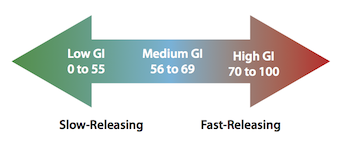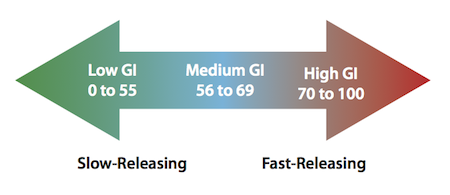As stated in the Carbohydrates section, maintaining stable blood sugar levels is important for maintaining stable energy levels throughout the day and for maintaining a healthy weight. Consuming simple, fast-releasing carbohydrates leads to a rapid elevation in blood sugar levels that is followed by a rapid decrease in blood sugar levels. These rapid variations in blood sugar essentially prevent the use of fat as fuel and over time can promote weight gain. On the other hand, consuming complex, slow-releasing carbohydrates has a steadying effect on blood sugar levels.
But, how does one know how much consuming a specific food will raise glucose levels?
The Glycemic Index (GI)
Fortunately, a scale known as the Glycemic Index provides a scale with which to estimate how much consuming a specific food will raise blood glucose levels. (Additionally, another scale, known as the Glycemic Load, provides a more practical and accurate assessment of how consuming a specific food will affect blood sugar levels by taking into account the quantity of carbohydrates consumed as well as the glycemic index. See Glycemic Load).
The Glycemic Index (GI) ranges from 0 to 100. A GI of 0 to 55 is considered low, a GI of 56 to 69 is medium, and a GI of 70 to 100 is high. Foods with carbohydrates that are broken down more slowly and help maintain steady blood sugar levels have low GIs. Foods with carbohydrates that are broken down more quickly and lead to rapid elevations in blood sugar levels have high GIs.
The table below provides a brief guide to the glycemic index based on general types of foods. To help maintain stable blood sugar levels, limit consumption of foods that are high on the GI scale. Instead, eat foods that are classified as low or medium on the GI scale. (For a comprehensive table with specific food items see Glycemic Index Chart and Glycemic Load Chart).
|
Quick GI Guide |
||
| Classification | GI Range | Food Types |
| Low | 55 or less | Most fruits, nonstarchy vegetables, legumes (dry beans), milk |
| Medium | 56 to 69 | Whole wheat products such as bread or pasta, brown or basmati rice, sweet potato |
| High | 70 or more | Baked potatoes, french fries, white bread, corn flakes, crackers |
EMG’s Nutrition Homepage: How to Eat Healthy






